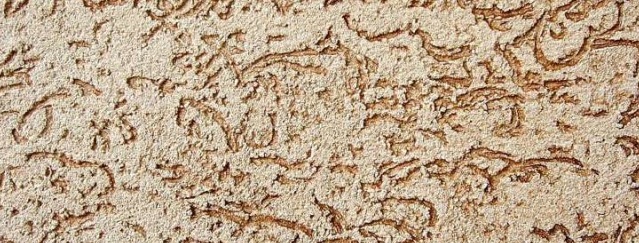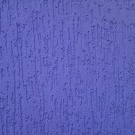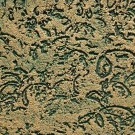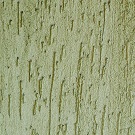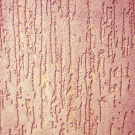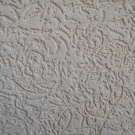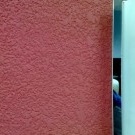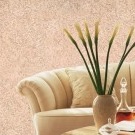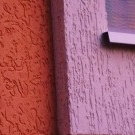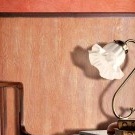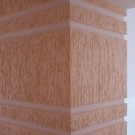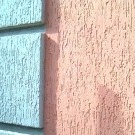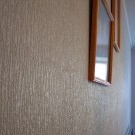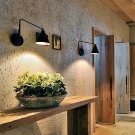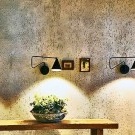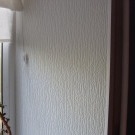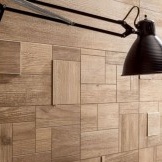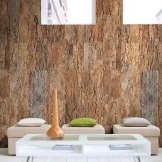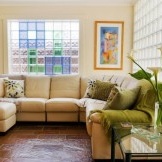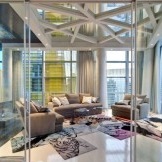Decorative plaster bark beetle: video of application and photo in the interior
Decorative bark beetle stucco is perhaps one of the most interesting and original finishes surface. This material with a talking name in appearance resembles a source tree and is used for both internal and external works. Various irregularities give the plaster a colorful look and help create a cozy and relaxing atmosphere in the house. It is no secret to anyone that a monotonous (especially shiny) surface is quite annoying, while a bark beetle can bring peace and tranquility.
How is the effect of bark beetle achieved? In many ways, this texture is achieved thanks to the marble chips, which are part of its composition. During application with a spatula, the same crumb “scratches” the furrows, due to which oblong and narrow recesses are obtained. The width and depth of the furrow depends on the size of the grains, which, in turn, are from 0.1 to 3.5 mm. That is, the composition may include both small and larger grains of sand. Today, the most popular option is considered to be a bark beetle with crumbs from 2 to 2.5 mm.
Characteristic of bark beetle plaster
As already mentioned earlier, the material is used both for internal and external work. This versatility is associated with superior performance. Let's take a closer look:
- Resistance to weather conditions. The bark beetle withstands temperatures from -55 to +60, does not fade in the sun, does not weather and does not get wet in the rain.
- It hides minor defects and uneven walls.
- Resistance to mechanical damage: it is difficult to damage or scratch it.
- Resistance to aggressive environments. At the same time, the bark beetle does not emit harmful substances, which makes it environmentally friendly.
- Durability. Indoors, the material is able to maintain its original appearance up to 15 years, and outside up to 7 years.
- The surface covered with plaster can be easily repainted with acrylic or water-based paint. This is very convenient, because for many years you will want to refresh the interior of the house.
- Easy to clean: can be washed with a rag, brush or even a vacuum cleaner.
Let's look at the decorative bark beetle plaster in the interior
How to choose a bark beetle plaster
The material is available in bags (in the form of a dry mixture) and in buckets (pasty mixtures). This must be taken into account, because there will be fewer problems with the finished mixture, but it also costs more. This is due to the fact that the material is prepared with the addition of synthetic fillers.
Most often on the market you will find material in white, although sometimes you can stumble on other colors. Why is this done? Everything is simple - if desired, the mixture can take on any shade and this can be done in several ways. The first is to add dye to the plaster during mixing, and the second is to color the already dried surface. A feature of the material is unlimited decorative possibilities, because the “source” pattern can be applied in various ways: crosswise, in circles, waves or even randomly. In this case, the material is quite simple to use and is able to hide minor errors that you can make during the application.
Today in the market there is a great demand for decorative plaster and each manufacturer is trying to praise their products in all possible ways. But in fact, if the technology was maintained in the manufacture of the material, then there simply cannot be a significant difference in quality. Therefore, when choosing decorative plaster, focus on your own taste and carefully read the finished samples. Imported plaster practically does not differ in quality from domestic manufacturers, but it is still not worth saving.After all, the cheaper the material, the greater the likelihood that the production technology was not sustained or was completely produced in a makeshift way.
What else needs to be considered when choosing a bark beetle plaster? Well, first of all, you need to know that the material consumption may vary and depends on the diameter of the mineral grain that is included in its composition. For example, with a grain diameter of 2.5 mm, you will need 3 kg of plaster per 1 m2and with a size of 3.5 mm - 4 kg / m2.
Scope and preparation of bark beetle plaster
The material is used both for walls and ceilings. It can be used on any surface that is capable of adhesion (in other words, adhesion) and will not bend during operation: drywall, brick, concrete, chipboard, cement plaster, etc. The bark beetle is a topcoat and is applied in a small layer (a little more than the diameter of the grain), so do not try to fill in large cracks and pits on the walls.
The bark beetle is applied on a flat, primed and clean surface. Therefore, if there are traces of paint, lime or other materials, then they must be removed.
The technology for applying bark beetles and methods for its preparation are described in detail in the instructions on the purchased material. It is she who needs to be guided. But the general indication will be as follows:
- when preparing the mixture, the plaster is poured into the water, and not vice versa;
- water should be warm, about 20 ° C;
- The solution is mixed with a drill with a mixer nozzle and at low speeds;
- it’s not worth doing this manually; it’s still not possible to stir qualitatively;
- stirring occurs until lumps are noticeable. After this, the material needs to settle for about 5 minutes and mix it again;
- the proportions of water, dry plaster mix and the duration of bark beetle use depend on the specific brand and are indicated in the instructions. One mixture may already set in an hour, while another and calmly lie in the container for three hours. At the same time, freshening up with water will not work. That is why it is so important to follow the instructions from the manufacturer.
Application of decorative bark beetle plaster
- A small amount of the mixture is applied to the surface and smeared with a uniform, thin layer.
- After the material has thickened (this is approximately 30 minutes), it is necessary to lightly and glidingly move along the surface with a grater. This is necessary to align the layer and create a picture. Beginners can use simpler, traditional types of patterns: rain, waves, circles, etc. The main thing is confident and gentle movements, do not put too much pressure on the grater. Remember, the longer the bark beetle is rolled out - the less noticeable the pattern will turn out, the surface will become glossy and the plaster effect will be lost.
- When working with a large surface, it is advisable to enlist the help of a friend: one applies the plaster, and the other wipes the surface. The bark beetle is quite simple to apply, even beginners are able to cope with a similar task.
- The recommended temperature of the working room should remain between +5 and +25 degrees. But if a multi-colored coating acts as a mixture, then the room should not be colder than +10 degrees.
- It is advisable to apply the plaster without a break, in one go. But if circumstances force, then on the border of the applied mixture masking tape should be glued, so the material will not dry out. Depending on the brand, the bark beetle dries from 1 to 5 days. After you can start staining. If acrylic paint is used for this, then 5 days will be short, it’s worth waiting a couple of weeks. And for silicate and 3 days will be enough.
We check the quality. Well-done work is visible immediately: without joints, there is no "gloss", the surface is textured. Otherwise, cracks may appear after a few weeks if the material was not laid correctly or too thick.

